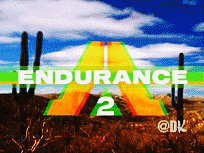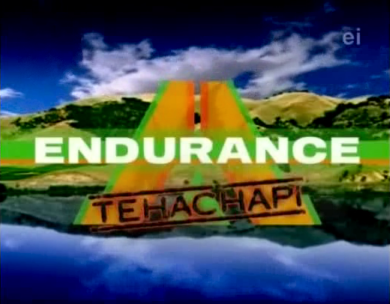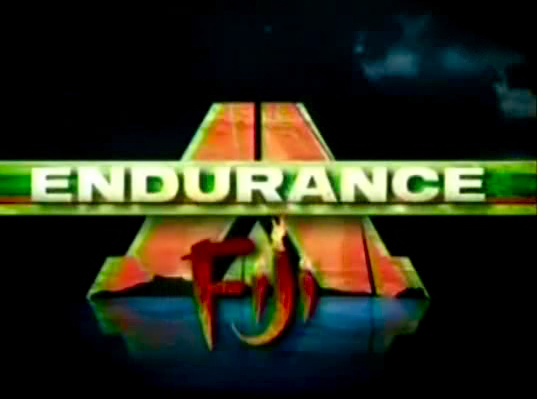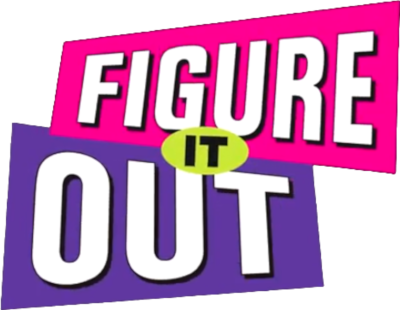My next few posts will touch upon the subject of some of the community and even my own personal favorite game shows. The series which I'll be talking about follows as shown here: (network is indicated in parentheses)
BrainSurge (Nickelodeon; 2009-present)
* This is one of Nickelodeon's newest game shows, débuting in September 2009 and spanning 3 seasons so far. The host is former PickBoy from U-Pick Live Jeff Sutphen; here's the general formula of the show plays out:
Double Dare (Nickelodeon; 1986-1993/2000-2001)
* This is one of Nickelodeon's older game shows, premiering in October 1986 and ending in February 1993; it was revived for the new millennium between January to December 2000. The host is Marc Summers, who also hosted What Would You Do? from 1991-1993; here's the general formula of the show plays out:






Endurance (Discovery Kids/The Hub; 2002-2008)
* This was Survivor's teenaged counterpart for their show; in fact, it's one of the best teen reality shows ever produced in TV history. Anyway, the show's hosted by game show veteran JD Roth, and it made its début in October 2002 but ended in March 2008 (what a shame!). As it turns out, there was one series prior to this— its name was Moolah Beach, and it aired on FOX Family; it actually set the norm for the REAL Endurance! Might as well knock out the show formula and the episodes:
~Water extinguishes Fire
~Fire scorches Wood
~Wood is buoyant on Water
 Figure It Out (Nickelodeon; 1997-2001/2012-present)
Figure It Out (Nickelodeon; 1997-2001/2012-present)
*


 GUTS/Global GUTS/My Family's Got GUTS (Nickelodeon; 1992-1996/2008-2010)
GUTS/Global GUTS/My Family's Got GUTS (Nickelodeon; 1992-1996/2008-2010)
*


 Legends of the Hidden Temple (Nickelodeon; 1993-1996)
Legends of the Hidden Temple (Nickelodeon; 1993-1996)
*
 Nick Arcade (Nickelodeon; 1992-1994)
Nick Arcade (Nickelodeon; 1992-1994)
*
BrainSurge (Nickelodeon; 2009-present)
* This is one of Nickelodeon's newest game shows, débuting in September 2009 and spanning 3 seasons so far. The host is former PickBoy from U-Pick Live Jeff Sutphen; here's the general formula of the show plays out:
- Level One (aka Brain Teaser) premieres six players who'll begin a sequence of four to six visual puzzles— each of whom is worth 10, 20, 30, 40, 50 and 100 points consecutively (if a player memorizes all six puzzles correctly, their maximum is 250 points). The first four contestants who have highest sums out of all six players can progress to Level Two— if there's a tie between players, the judges will break the tie by determining how quickly the player confirmed their answers into the keypad. When contestants are eliminated, they'll have to slide down: THE BRAIN DRAIN— in one ear and out the other ear!
- Level Two (aka Brain Freeze) involves the four players listening to a story read aloud by Jeff— the stories, although he claims that they're 100% unequivocally true actually are only exaggerated— who'll then ask them questions about the tale afterward. To respond to each question, contestants sit in a hand-chair, and if their answer's incorrect, the chair farts, and sucks the player through one of the big face's teeth! The final two contestants showdown in the Knockout Round— in this segment, they're granted 10 seconds to memorize a 16-image grid, with 8 pairs of story pics; if a contestant incorrectly matches two images, a sudden-death match determines who wins this level. At this point, the other 3 eliminated players slide down the Brain Drain and leave with a consolation prize— which is more expensive than Level One's prizes!
- Level Three (aka Brain Trip) is where the last player standing has to trace out three illuminating paths on a 4x4/5x5/6x6 grid in 90 seconds; if they can win in 90 seconds, they're given three prizes for each grid— based on how furthest along they are when 90 seconds is up; plus, they get Nickelodeon's trademark slime!
Double Dare (Nickelodeon; 1986-1993/2000-2001)
* This is one of Nickelodeon's older game shows, premiering in October 1986 and ending in February 1993; it was revived for the new millennium between January to December 2000. The host is Marc Summers, who also hosted What Would You Do? from 1991-1993; here's the general formula of the show plays out:
- The show would open with two teams competing for $100 in three physical and sloppy challenges; the final round was an obstacle course where the winning team would get $2000 for completing all eight objectives.






* This was Survivor's teenaged counterpart for their show; in fact, it's one of the best teen reality shows ever produced in TV history. Anyway, the show's hosted by game show veteran JD Roth, and it made its début in October 2002 but ended in March 2008 (what a shame!). As it turns out, there was one series prior to this— its name was Moolah Beach, and it aired on FOX Family; it actually set the norm for the REAL Endurance! Might as well knock out the show formula and the episodes:
- 20 contestants are selected from thousands of applicants generally during April to June of the year (this and more about the casting process was revealed in the Endurance: Hawaii—Casting Special), and they arrive on a remote location in the country or the world (i.e. Pacific Islands, Mexico, Hawaii, Tehachapi Mountains, Shaver Lake/High Sierras, Fiji), and the games begin!
- After they arrive and move into their cabins (which are accommodations for the season) for a couple hours or a full day, they must combat the opening challenge— the Right to Stay! This game required numerous kinds of equipment, but the goal was this: the first two or three boys and girls who failed to have endurance would be eliminated, and the remaining contestants would add on further progress over the next several weeks.
- In Endurance: Hawaii and Endurance: High Sierras, one or two boys and girls would be granted access to a free ride from the Right to Stay— the other contestants would vote and reach a consensus on who should be given the free ride, and whoever received it would advance to the real competition!
- The following day, the remaining twelve, fourteen or sixteen competitors will be auctioned off into six, seven or eight teams— colors are purple, red, blue, orange, gray, green, yellow and brown— which would compete for the grand prize trip which will be won in the season finale. At the end of the day, each team would be handed one pyramid piece and the team who acquired all pyramid pieces first would win— respectively, 10 pieces were in E1, 12 pieces were in E2 and E3, 13 pieces were in E4 and E5, 14 pieces were in E6 et al.
- With the teams now configured, they'd all compete in two sorts of challenges— Endurance Missions and Temple Missions. Endurance Missions are generally gauges of skills and stamina, while Temple Missions are themed around endurance (henceforth, the show gets its name!). The huge difference between these challenges is this: the former mission has a pyramid piece and the Samadhi (which is a negative hindrance for the follow-up Temple Mission), while the latter allows the victor to send two teams to the Temple of Fate.
- When two teams were sent to the Temple of Fate, they'd haul all pyramid pieces owned by them, and they'd battle it out in a Rock-Paper-Scissors-styled game (or you may call it the expanded version, which is Rochambeau) where the score would be confirmed by a 2-outta-3 match as follows:
~Water extinguishes Fire
~Fire scorches Wood
~Wood is buoyant on Water
- The first team two win two rounds would continue to participate in the game, whereas the losing team would be eliminated instantaneously (they'd evaporate into thin air behind the kettle's flames, which was only a visual effect added in post-production); in E1, the eliminated team's piece would be won as an aftereffect by the winning team— in all consequential seasons, eliminated teams could hand their piece to the they wanted to have it along with a departure letter.
- On the final day of Endurance, the final two teams play in one last challenge for the remaining pyramid pieces, and at the Temple of Fate, they'd get quarter-scale pieces which would be chips for a shell-game in the Finale Championship; the team with less pieces would go first, etc. and the team that won all pyramid pieces first would win the grand prize trip.

*



*



*
*


No comments:
Post a Comment